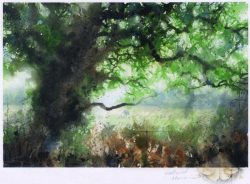 FORMER associate editor and senior artist at The Sunday Times, environmental artist Gary Cook has been exploring the mysterious and beautiful remnants of England’s temperate rainforests, and the results are on show in a powerful exhibition at The Art Stable at Child Okeford, running to 20th July.
FORMER associate editor and senior artist at The Sunday Times, environmental artist Gary Cook has been exploring the mysterious and beautiful remnants of England’s temperate rainforests, and the results are on show in a powerful exhibition at The Art Stable at Child Okeford, running to 20th July.
After graduating from Bournemouth University in the late 1980s, Gary, who lives near Shaftesbury, worked on newspapers for 26 years and it was his experience at The Sunday Times that in part inspired his interest in environmental issues. He says: “I often produced diagrams highlighting environmental problems. In the last decade as a painter, including an environmental message in each piece has been very important to me. For example, oak trees provide the habitat for around 2,300 different species from bats to beetles and lichens to mammals. The names and silhouettes of some of these species are discreetly included in my paintings.”
His research and painting trips for the new exhibition, Temperate Times, took him to Devon, Cornwall, Wales and the Lake District, exploring and recording these magical and atmospheric ancient woods. We tend to think of the Amazon or the deep, dark, wildlife-rich jungles of central Africa or the Indonesian archipelago when we imagine rainforests – but those are tropical. Temperate rainforests are among the most beautiful and fragile environments in the world, at risk of climate change and other manmade threats. There is a major temperate rainforest in the Olympia peninsula of Washington State in the USA, but the English forests are much smaller.
 The best known surviving English temperate rainforest is Wistman’s Wood, the extraordinary, ancient woodland near Two Bridges on Dartmoor. Visiting this wood is like walking into a magical landscape that could have been described by Tolkien. It has been a designated Site of Special Scientific Interest for 60 years, and has additional protection as part of a National Nature Reserve.
The best known surviving English temperate rainforest is Wistman’s Wood, the extraordinary, ancient woodland near Two Bridges on Dartmoor. Visiting this wood is like walking into a magical landscape that could have been described by Tolkien. It has been a designated Site of Special Scientific Interest for 60 years, and has additional protection as part of a National Nature Reserve.
It is estimated that temperate rainforests used to cover about 20 percent of this country – now it is less than one per cent. In his notes on his exhibition at The Art Stable, Gary comments that there may still be some small remnants in Dorset. Explaining how the project began, he says he had been reading Guy Shrubsole’s book The Lost Rainforests of Britain, and was struck by the author’s descriptions of the plants to look out for, because they were ‘telltale signs of these magical, enveloping places.’ They include gnarly, moss-covered oak branches: “The clue is in the name – they need rain,” Gary says.
 Shaftesbury is surrounded by ancient holloways, of which Dinah’s Hollow on the C13 at Melbury Abbas is probably the best-known. Gary began exploring these deep damp byways and valleys around the town. There is, he says, a theory that the oaks that grow here may be remnants of rainforests. You may have walked in some of the places he has painted, in Dorset or further afield: “Some of the small tracts I have painted around the country are actually in popular tourist areas,” he says.
Shaftesbury is surrounded by ancient holloways, of which Dinah’s Hollow on the C13 at Melbury Abbas is probably the best-known. Gary began exploring these deep damp byways and valleys around the town. There is, he says, a theory that the oaks that grow here may be remnants of rainforests. You may have walked in some of the places he has painted, in Dorset or further afield: “Some of the small tracts I have painted around the country are actually in popular tourist areas,” he says.
Gary, who is a member of the Royal Institute of Painters in Water Colours and the Society of Graphic Fine Art, is an elected member of the group of artists working in many different media including wood and stone, who call themselves The Arborealists. He contributes to Resurgence and Ecologist magazine. The Temperate Times exhibition at The Art Stable continues to 20th July. For more information on his work, and future exhibitions and projects, visit his website, https://www.cookthepainter.com
Pictured are three of Gary’s rainforest paintings: Oak in the Bracken, Moss and Ferns, and Winter in the Rainforest; all ink, watercolour and charcoal